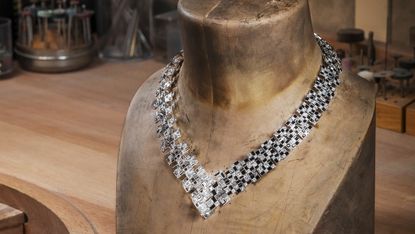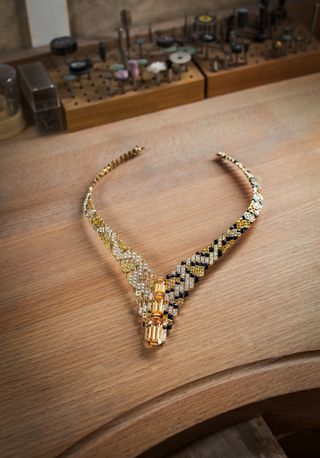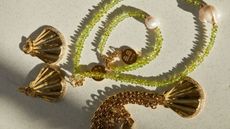Cartier Sixième Sens: a new high jewellery collection for the senses
Parisian master jeweller works with sense, sensibility and savoir faire

With its new made-in-Paris treasures, Cartier has made a plan to tantalise. Unveiled this month, Sixième Sens par Cartier, the master jeweller’s latest high jewellery collection, counts a number of landmark creations. All are realised from prestige materials – including emeralds, sapphires, garnets and, in the case of the Coruscant necklace, diamonds of six different cuts, among them kite, baguette and triangle – their obtainment adhering to the code of practice of the Responsible Jewellery Council.
The collection’s name translates as “sixth sense”; instead of an academic or scientific reading of the five basic human senses – sight, touch, smell, taste, hearing – and sensory perception, Cartier instead approaches the theme with creative flair. Take, for example, Cartier’s Phaan ring. Here, a complex tiered construction frames an outsized ruby of 8.20 carats with diamonds and ruby balls that glisten when the light hits. The central stone itself has been placed atop a rose-cut diamond: it’s a precious lighting aide that further amplifies the ruby’s saturated red hue, which calls to mind sweetly-scented fruit or a flavoursome treat.
Next up: hearing, a sense that may be matched with Cartier’s Alaxoa necklace. Made up of many bright green emeralds and dotted with light-refracting diamonds, the design is the result of a labour-intensive technique that at Cartier has heritage, and requires makers to artfully match gems in colour and size, before threading individual stones onto a thin wire to form slim strands and cascading fringes. These are then linked with small metal bridges; the goal is a collier that is mobile, has volume and moves just so.
Subscribe to The Week
Escape your echo chamber. Get the facts behind the news, plus analysis from multiple perspectives.

Sign up for The Week's Free Newsletters
From our morning news briefing to a weekly Good News Newsletter, get the best of The Week delivered directly to your inbox.
From our morning news briefing to a weekly Good News Newsletter, get the best of The Week delivered directly to your inbox.

The making of the Alaxoa necklace remains by far not the only homage Cartier has paid to its illustrious past with Sixième Sens: a Parhelia ring with a cabochon-cut sapphire of 21.51 carats is of architectural appeal and updates the maison’s peacock motif, a blue-and-black colour combination first made popular by Louis Cartier.
Cartier’s Meride necklace – its list of ingredients counts diamonds, black onyx and rock crystal – follows a checkerboard inspiration. Monochrome, multi-layered and seemingly caught mid-movement, with its Meride, Cartier plays tricks on the eye. The gem’s visual illusions are a high-carat nod to the masterworks of optical art.
It’s a comparison that could also be made for the yellow-gold Pixelage necklace, a tribute to the panther paid in topaz, onyx, diamonds and coloured diamonds. At Cartier, the wild cat has been house-mascot since 1914, when the brand debuted a wristwatch lavished in onyx and diamonds, its pattern recreating the animal’s distinctive fur, and commissioned George Barbier with the illustration for a paper invitation starring the noble creature. This year’s evocation also homes in on the panther's marbled fur in a geometric collar that meets in a trio of golden-hued topazes. Sparkling and of undulating surface, Pixelage is inviting to the fingertips.
Sign up for Today's Best Articles in your inbox
A free daily email with the biggest news stories of the day – and the best features from TheWeek.com
Create an account with the same email registered to your subscription to unlock access.
-
 Magazine interactive crossword - May 3, 2024
Magazine interactive crossword - May 3, 2024Puzzles and Quizzes Issue - May 3, 2024
By The Week US Published
-
 Magazine solutions - May 3, 2024
Magazine solutions - May 3, 2024Puzzles and Quizzes Issue - May 3, 2024
By The Week US Published
-
 Magazine printables - May 3, 2024
Magazine printables - May 3, 2024Puzzles and Quizzes Issue - May 3, 2024
By The Week US Published
-
 Otiumberg: sustainable jewellery beyond the hype
Otiumberg: sustainable jewellery beyond the hypeUnder the radar Launched by two sisters, this London-based brand has gone from strength to strength
By Alexandra Zagalsky Published
-
 Best UK literary festivals and book fairs in 2023
Best UK literary festivals and book fairs in 2023feature A look at some the biggest events for book lovers in Britain in 2023
By The Week Staff Published
-
 Fabulous foodie adventures in Peru, Japan and Australia
Fabulous foodie adventures in Peru, Japan and Australiafeature Featuring a Peruvian pilgrimage and foraging in the Volcanic Lakes and Plains
By The Week Staff Published
-
 Top 10 best debut novels of all time
Top 10 best debut novels of all timefeature Harry Potter and the Philosopher’s Stone took top spot in a poll of British literary lovers
By The Week Staff Published
-
 Watership Down: disturbing children’s film finally loses its U rating
Watership Down: disturbing children’s film finally loses its U ratingfeature The 1978 adaptation of Richard Adams’s novel no longer feels ‘suitable for all’
By The Week Staff Published
-
 How to pack efficiently and save on airfares
How to pack efficiently and save on airfaresfeature Travel tips and hacks for making the most of a bargain flight
By Alexandra Zagalsky Published
-
 Essential jewellery pieces to wear this summer
Essential jewellery pieces to wear this summerThe Week Recommends Add exuberant and playful items to your summer capsule wardrobe
By Alexandra Zagalsky Published
-
 Edge of Ember: affordable fine jewellery for classicists
Edge of Ember: affordable fine jewellery for classicistsfeature London-based brand has gone from strength to strength with its youthful and elegant designs
By Alexandra Zagalsky Published